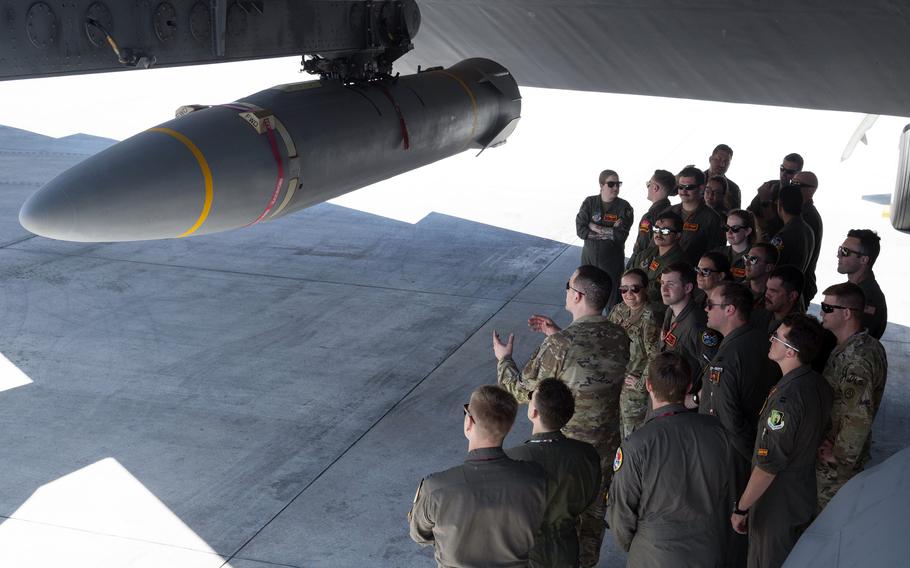
B-52 Stratofortress crews from North Dakota and Louisiana learn more about hypersonic weapons at Andersen Air Force Base, Guam, Feb. 27, 2024. (Pedro Tenorio/U.S. Air Force)
TOKYO — The United States and Japan have agreed to develop a defensive weapon to counter the threat from hypersonic missiles, both countries announced this week.
The Department of Defense and Japan’s Ministry of Defense signed an agreement Wednesday to jointly develop interceptors to take down the elusive, ultrafast missiles, according to a news release on the DOD website.
The longtime allies had indicated, after high-level meetings in August, that they’d cooperate on the project.
Both China and Russia have fielded hypersonic weapons that can travel five times the speed of sound and maneuver in flight like a cruise missile, making them difficult to detect and shoot down.
North Korea recently reported the successful ground test of a solid-fuel engine for a new type of intermediate hypersonic missile, a test overseen by the country’s autocratic leader Kim Jong Un.
In March, the U.S. Air Force conducted its first hypersonic missile test in the Western Pacific.
The Missile Defense Agency is leading development of the interceptors, which will defend against missiles during the glide-phase portion of hypersonic flight, according to the release.
“By pursuing an agreement on [glide-phase interceptor] development, the U.S. and Japan will strengthen regional deterrence while enhancing long-standing missile defense cooperation between the two countries,” the DOD release states.
Japan will lead development of rocket motors and propulsion components of the hypersonic missile interceptors, the announcement said.
Japan wants to swiftly bolster interception capabilities, according to a statement posted Wednesday on the Defense Ministry’s website.
“Missile-related technologies, such as hypersonic weapons, have improved dramatically around Japan and … have been significantly strengthened both in quality and quantity,” the statement said. “Strengthening the ability to intercept these weapons is an urgent issue.”
Joint development of the interceptors will start before March with the project scheduled for completion in the 2030s, according to Japan’s statement.
A glide-phase interceptor “is an asset that contributes to the improvement of Japan’s integrated air-defense missile capabilities and also contributes to the improvement of the deterrence and response capabilities of the Japan-U.S. alliance,” the statement said.
Developing a check to hypersonic missiles is a technical challenge, including the design of openings for radar and laser sensors, according to Lance Gatling, an American defense analyst in Tokyo.
“The interceptors themselves must integrate advanced sensors to make final sensing before impact,” he wrote in an email Thursday.
Existing technology may be adapted to save time, Gatling said.
“The challenge is adapting everything to work at much higher speeds against a maneuvering target, which is one of the key aspects of offensive hypersonic missiles, unlike ballistic missiles, which follow a more or less predictable, relatively smooth path,” he said.
The new interceptors will be integrated with the Aegis missile defense system already in use by the U.S. and Japan and they may have to carry multiple warheads, Gatling added.
The U.S. and Japan collaborating on hypersonic missile defense is a positive step considering potential threats from China, Russia and North Korea, said Ralph Cossa, a retired Air Force officer and former president of the Pacific Forum think tank in Hawaii.
The project could be a bid for Japanese participation in the AUKUS — Australia, United Kingdom and United States — security pact, which includes collaboration across a range of defense capabilities, he said by email Thursday.
“Japan wants to get into more hi-tech cooperation and has apparently been knocking on AUKUS’ door,” Cossa wrote. “Perhaps this helps open the door a bit.”